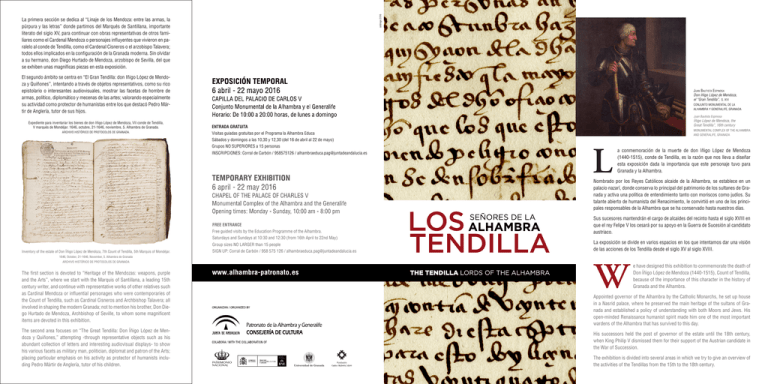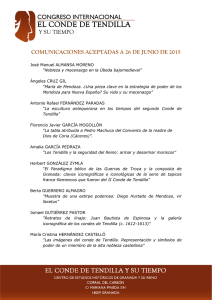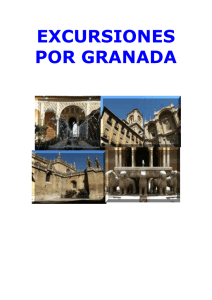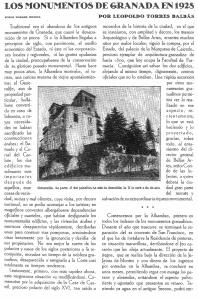Folleto de la exposición - Patronato de la Alhambra y Generalife
Anuncio

catálogo 2016 La primera sección se dedica al “Linaje de los Mendoza: entre las armas, la púrpura y las letras” donde partimos del Marqués de Santillana, importante literato del siglo XV, para continuar con obras representativas de otros familiares como el Cardenal Mendoza o personajes influyentes que vivieron en paralelo al conde de Tendilla, como el Cardenal Cisneros o el arzobispo Talavera; todos ellos implicados en la configuración de la Granada moderna. Sin olvidar a su hermano, don Diego Hurtado de Mendoza, arzobispo de Sevilla, del que se exhiben unas magníficas piezas en esta exposición. El segundo ámbito se centra en “El Gran Tendilla: don Iñigo López de Mendoza y Quiñones”, intentando a través de objetos representativos, como su rico epistolario o interesantes audiovisuales, mostrar las facetas de hombre de armas, político, diplomático y mecenas de las artes; valorando especialmente su actividad como protector de humanistas entre los que destacó Pedro Mártir de Anglería, tutor de sus hijos. Juan Bautista Espinosa Don Iñigo López de Mendoza, el “Gran Tendilla”, S. XVI CONJUNTO MONUMENTAL DE LA ALHAMBRA Y GENERALIFE, GRANADA Juan Bautista Espinosa Expediente para inventariar los bienes de don Iñigo López de Mendoza, VII conde de Tendilla, V marqués de Mondéjar. 1646, octubre, 21-1646, noviembre, 5. Alhambra de Granada. ARCHIVO HISTÓRICO DE PROTOCOLOS DE GRANADA. Íñigo López de Mendoza, the Great Tendilla”, 16th century ENTRADA GRATUITA MONUMENTAL COMPLEX OF THE ALHAMBRA AND GENERALIFE, GRANADA Visitas guiadas gratuitas por el Programa la Alhambra Educa Sábados y domingos a las 10,30 y 12,30 (del 16 de abril al 22 de mayo) Grupos NO SUPERIORES a 15 personas INSCRIPCIONES: Corral de Carbón / 958575126 / [email protected] L a conmemoración de la muerte de don Iñigo López de Mendoza (1440-1515), conde de Tendilla, es la razón que nos lleva a diseñar esta exposición dada la importancia que este personaje tuvo para Granada y la Alhambra. Nombrado por los Reyes Católicos alcaide de la Alhambra, se establece en un palacio nazarí, donde conserva lo principal del patrimonio de los sultanes de Granada y activa una política de entendimiento tanto con moriscos como judíos. Su talante abierto de humanista del Renacimiento, le convirtió en uno de los principales responsables de la Alhambra que se ha conservado hasta nuestros días. FREE ENTRANCE Free guided visits by the Education Programme of the Alhambra. Saturdays and Sundays at 10:30 and 12:30 (from 16th April to 22nd May) Group sizes NO LARGER than 15 people Inventory of the estate of Don Íñigo López de Mendoza, 7th Count of Tendilla, 5th Marquis of Mondéjar. 1646, October, 21-1646, November, 5. Alhambra de Granada ARCHIVO HISTÓRICO DE PROTOCOLOS DE GRANADA The first section is devoted to “Heritage of the Mendozas: weapons, purple and the Arts”, where we start with the Marquis of Santillana, a leading 15th century writer, and continue with representative works of other relatives such as Cardinal Mendoza or influential personages who were contemporaries of the Count of Tendilla, such as Cardinal Cisneros and Archbishop Talavera; all involved in shaping the modern Granada; not to mention his brother, Don Diego Hurtado de Mendoza, Archbishop of Seville, to whom some magnificent items are devoted in this exhibition. The second area focuses on “The Great Tendilla: Don Íñigo López de Mendoza y Quiñones,” attempting -through representative objects such as his abundant collection of letters and interesting audiovisual displays- to show his various facets as military man, politician, diplomat and patron of the Arts; placing particular emphasis on his activity as protector of humanists including Pedro Mártir de Anglería, tutor of his children. SIGN UP: Corral de Carbón / 958 575 126 / [email protected] Sus sucesores mantendrán el cargo de alcaides del recinto hasta el siglo XVIII en que el rey Felipe V los cesará por su apoyo en la Guerra de Sucesión al candidato austriaco. La exposición se divide en varios espacios en los que intentamos dar una visión de las acciones de los Tendilla desde el siglo XV al siglo XVIII. W e have designed this exhibition to commemorate the death of Don Íñigo López de Mendoza (1440-1515), Count of Tendilla, because of the importance of this character in the history of Granada and the Alhambra. Appointed governor of the Alhambra by the Catholic Monarchs, he set up house in a Nasrid palace, where he preserved the main heritage of the sultans of Granada and established a policy of understanding with both Moors and Jews. His open-minded Renaissance humanist spirit made him one of the most important wardens of the Alhambra that has survived to this day. His successors held the post of governor of the estate until the 18th century, when King Philip V dismissed them for their support of the Austrian candidate in the War of Succession. The exhibition is divided into several areas in which we try to give an overview of the activities of the Tendillas from the 15th to the 18th century. En un tercer ámbito atendemos a los inmediatos sucesores del alcaide y que englobamos con el título “Los Mendoza del Renacimiento”. Entre ellos destacamos a su primogénito y heredero, Luis Hurtado de Mendoza, que fue el responsable de la construcción del Palacio de Carlos V, pero también entre los hijos del Gran Tendilla tenemos que reseñar otros perfiles como los de Diego Hurtado de Mendoza, embajador y escritor (del que mostramos en la exposición un magnífico retrato atribuido a Tiziano), o Antonio de Mendoza, virrey de la Nueva España y del Perú. Sección que termina con la Guerra de las Alpujarras que afectó negativamente al poder de los Tendilla dada su postura pactista con los moriscos. También nos sirve este espacio intermedio para presentar una vitrina con armas, de excepcional calidad, relacionadas con los relieves que el arquitecto Pedro Machuca haría para los basamentos del Palacio de Carlos V, comprobando la veracidad de sus dibujos al tener a su disposición una amplísima y documentada armería en la Alhambra. Ya en la cripta del Palacio, se dispone la cuarta sección que denominamos “La larga decadencia” que abarcaría desde la Guerra de las Alpujarras hasta el siglo XVIII en que los Tendilla son desposeídos por Felipe V de la alcaldía de la Alhambra. Periodo amplio y de enorme interés histórico donde, a partir del inventario de bienes del VII Conde de Tendilla, reconstruimos parte de los ajuares (textiles, libros, platería) que estuvieron en distintas estancias de estos palacios a mediados del siglo XVII, así como objetos de la vida cotidiana o referentes a los alcaides provenientes de excavaciones o remodelaciones realizadas modernamente en el conjunto de la Alhambra. Incluyendo, también, una restitución de lo que fue el palacio de los Tendilla destruido en el siglo XVIII. Un ámbito intermedio de esta exposición, aprovechando las escaleras de comunicación entre los dos grandes espacios expositivos de la capilla y cripta del Palacio de Carlos V, nos permite proponer una galería de retratos de aquellos miembros de la familia real que visitaron la Alhambra entre los siglos XV y XVIII. Tiziano Vecellio Retrato de Diego Hurtado de Mendoza, S. XVI Tiziano Vecellio Portrait of Diego Hurtado de Mendoza, 16th century GALERÍA PALATINA DEL PALAZZO PITTI, FLORENCIA PALATINE GALLERY AT THE PALAZZO PITTI, FLORENCE Como apéndice a esta sección cerramos, en la sala anexa, a modo de epílogo, con la historia familiar escrita por don Gaspar Ibáñez de Segovia, el último que mantuvo el título de Alcaide de la Alhambra. A lo que se añade una seleccionada bibliografía y audiovisuales que relatan la unidad de esta exposición y la genealogía de los Mendozas granadinos. Niccolo da Corte Basas de la fachada sur del palacio de Carlos V, entre 1538 y 1539. CONJUNTO MONUMENTAL DE LA ALHAMBRA Y GENERALIFE, GRANADA Niccolo da Corte Base of the façade of the Charles V palace, between 1538 and 1539. MONUMENTAL COMPLEX OF THE ALHAMBRA AND GENERALIFE, GRANADA Aljibe de Tendilla The third area is devoted to the immediate successors of the governor under the title “The Mendozas of the Renaissance”. These include his eldest son and heir, Luis Hurtado de Mendoza, who was responsible for the construction of the Palace of Charles V, but the children of the Great Tendilla also included other important characters such as Diego Hurtado de Mendoza, ambassador and writer (of whom the exhibition contains a magnificent portrait attributed to Titian), and Antonio de Mendoza, viceroy of New Spain and Peru. The section ends with the War of the Alpujarras, which adversely affected the power of the Tendillas because of their tolerant position with regard to the Moors. In an intermediate area of the exhibition, taking advantage of the stairs between the two large exhibition spaces of the chapel and crypt of the Palace of Charles V, we offer a gallery of portraits of the monarchs who used the Alhambra as Royal Palace between the 15th and 18th centuries. We also use this intermediate are to display a cabinet with weapons of exceptional quality, related to the reliefs that the architect Pedro Machuca made for the basements of the Palace of Charles V, owing the accuracy of his drawings to the availability of the extensive and well-documented armoury of the Alhambra. CONJUNTO MONUMENTAL DE LA ALHAMBRA Y GENERALIFE, GRANADA Anónimo hispano-romano Escultura Thoracata de emperador S. I- II d.C. MUSEO DE CÁDIZ Hispano-Roman Anonymous Thoracata Sculpture of Emperor 1st - 2nd century A.D. MUSEUM OF CADIZ Tendilla cistern MONUMENTAL COMPLEX OF THE ALHAMBRA AND GENERALIFE, GRANADA In the crypt of the Palace, we have set up the fourth section called “The long decline” stretching from the War of the Alpujarras to the 18th century when the Tendillas were dispossessed of the governorship of the Alhambra by Philip V; an extensive period of great historical interest in which, from the inventory of property of Count of Tendilla VII, we reconstruct some of the furnishings (textiles, books, silverware) to be found in the various rooms of these palaces in the mid-17th century and everyday objects or items related to the governors discovered during excavations and renovations carried out in the Alhambra complex in modern times; including also a restoration of what was once the palace of the Tendilla, destroyed in the 18th century. As an appendix to this section we finish, in the adjacent room, as an epilogue, with the family history written by Don Gaspar Ibáñez de Segovia, the last to hold the title of Governor of the Alhambra; in addition to a selected bibliography and audiovisual displays explaining the unity of the exhibition and the genealogy of the Mendozas of Granada.




